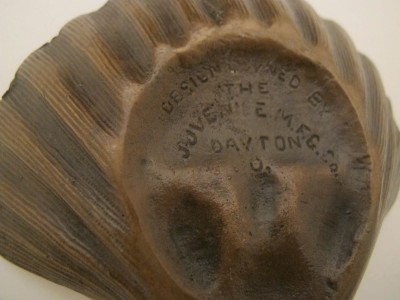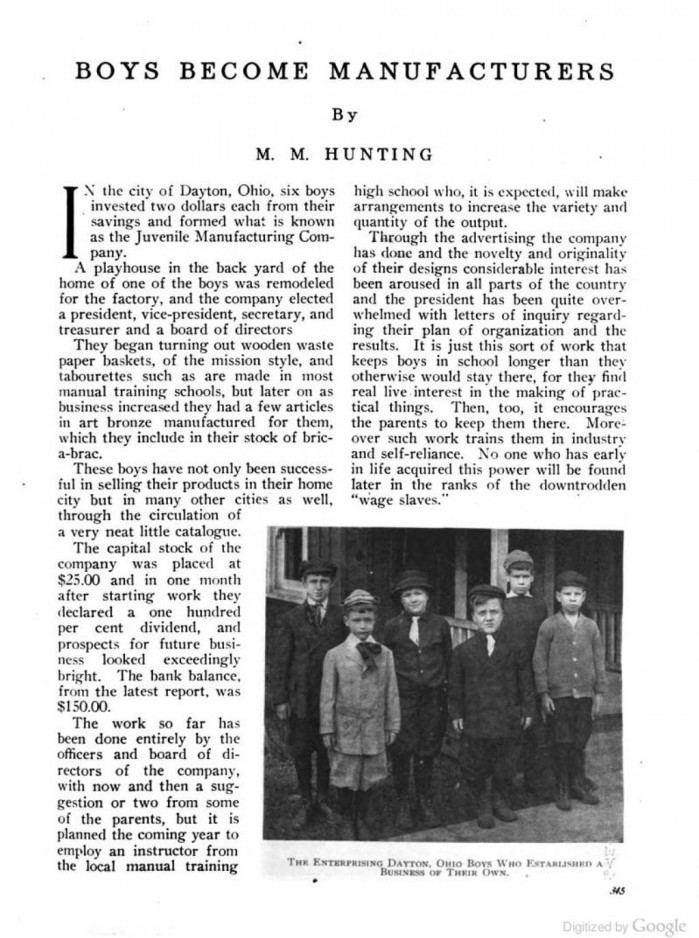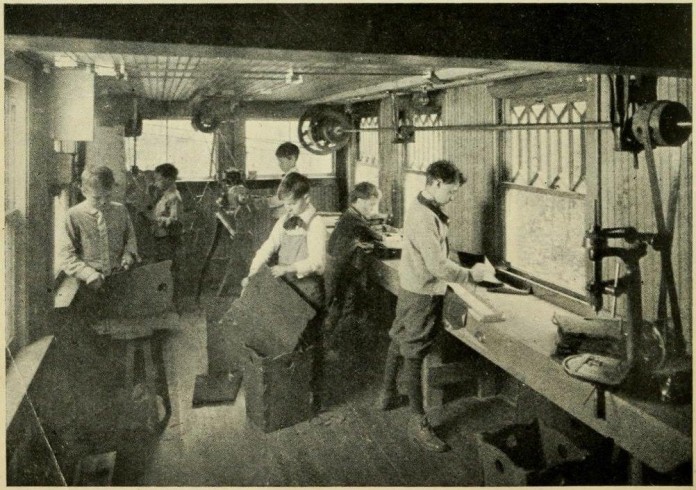The sound of saws ripping through wood and that of hammers pounding nails could be heard coming from the small factory located behind 319 Central Avenue in Dayton, Ohio. This was the address of the Juvenile Manufacturing Company that was created by six boys.
The boys, ranged from seven years of age to thirteen. Charles Deeds, a preciouses seven-year-old, was appointed President and General Manager; Fulton Davisson Jr., age 11, was Vice President and Superintendent; Robert Canby, age 10, the Secretary; Charles Whidden, age 13, served as Treasurer and Stanley Rouh, age 11, and Evan Whidden age 11 were both board members.
319 Central Avenue was the address of Edward Deeds and was made famous as the place where the electric self-starter was invented in 1911; but what makes it even more interesting is that at that same address the remodeled Deeds’ playhouse was home to the Juvenile Manufacturing Company. It was there the boys turned out an array of products: wooden waste paper baskets and stools made in the mission style. They also fabricated match safes and turned out pin, card and ashtrays in solid bronze.
On February 26, 1910 the boys formed the company, although not incorporated, they issued stock at $1.00 per share. The enterprise actually turned a profit, paying out dividends of 100% during its first year; and within that same period the company sold merchandise valued at over $150.00 ($3,750 in today’s dollars.) This was no playacting this was a real business run by boys, sans help from any direction. They could claim excellent references as to the financial solvency of the company, and all bills were paid on time by check. The company issued an eight-page catalog; the cover carried a picture of the factory with the schoolboys busy at work. The catalog was in part a prospectus touting the future plans for the company; included were descriptions and prices of items offered for sale. It also included days and hours of operation: “The plant is running Mondays, Thursdays and Fridays after school, and all days Saturdays. Visitors are welcome on Saturdays.” These youngsters were proud of the products they turned out and included the following in their catalog, “The purchaser of any article produced by this company is not only getting more value for the money paid than he could get in any store, but at the same time is encouraging a company of energetic little businessmen to get training that is most practical.”
An advertisement was run in the December 4, 1910 edition of the Dayton journal; it was in letter form on company stationery, composed by company president, Charles Deeds. It stated that during this Christmas season the company would open a store at 113 North Main Street, taking over the space of a now defunct bakery. The store was open from 4pm to 7pm each day; these hours suited the boys as they handled the flow of business also without outside help. Charles Deeds exhibited a talent for salesmanship far beyond his nine years; He promised his customers, if they bought a Christmas present from them, “it will please the one who gets it, make you happy, and we will be glad.” The Printers Ink, a journal for advertisers stated in their January 5, 1911 issue that this letter is “as good copy as can be seen anywhere.”

The story of Juvenile Manufacturing Company was picked up by several other publications; the Dayton News, Centennial edition devoted an entire page to the boys’ endeavors, as did the Dayton Journal. The American Boy, also devoted a full page to them, and the Dry Goods Economist as well as the September 1910 edition of Technical World Magazine, each ran columns describing the workings of the manufacturing company. In the November 25, 1911 issue of Publisher’s Weekly ran a detailed story on the boys’ business. And as a testament to their success when the book Handicraft for Handy Boys hit the bookstore shelves in 1911, the interior of the boys’ factory served as the front piece of the publication. This was all welcomed advertising and according to Charles Deeds, company president, it created an influx of correspondence from all parts of the country. The letters covered a wide range of subjects: The boys’ plan of organization, the novelty of their products and the keys to their success.
With all the attention garnered, the boys were having a hard time of it, filling orders; too many requests and too little time. They needed to expand operations; with this in mind an addition was added to the factory to handle the increased orders. Even while dealing with the extra business, the boys realized in looking to the future they had to expand their line of products. To achieve this goal, they turned to professor J. I. Lambert, a supervisor of manual training in the Dayton public schools. It was their hope he would teach them to build other types of furniture and other sundry items. But this never came to pass; by August, 1912 the Juvenile Manufacturing Company ceased operations when the two Whidden brothers moved to Canada with their parents.

This group of youthful businessmen eventually became the forerunner of the Junior Achievement franchise in the Dayton Area. And this foray into the world of business proved invaluable to these young entrepreneurs who went on to make their marks on the world. Charles Deeds went on to a successful career. In 1926 he helped found Pratt & Whitney Aircraft Company; becoming treasurer and director Pratt & Whitney Aircraft division. In 1928 with the formation of United Aircraft Company he was elected secretary and treasurer to the new company based in East Hartford, Connecticut. In the 1930’s he became president of another subsidiary, United Aircraft Exports Corporation. He later served as general manager of Pratt & Whitney.
In the 1940’s and 1950’s he was chairman and president of the Niles-Bement-Pond Company that became part of the gun maker, Colt Industries. As for the Whidden boys, Charles Ganong Whidden earned a Bachelor of Arts degree from Brandon College and was affiliated with McMaster University. His brother Reverend Evan Macdonald Whidden, listed in Canadian Who’s, Who, served as president of Brandon College as well as Dean of Theology at Acadia University, Wolfville, Nova Scotia. Robert C. Canby, who had lived just across the street from the factory on Central Avenue went on to serve as President of the Dayton Rotary Club in 1951-1952. And Oscar Fulton Davisson Jr., attended Yale University and became a renowned sculptor.

Sources:
-Advertisement: Oscar Fulton Davisson Sculpture Classes Tucson Daily Citizen, January 5, 1948.
-Article: Boys Advertise to Promote Co-operative Enterprise, Printers Ink, January 5, 1911.
-Article: Boys Become Manufacturers by M.M. Hunting, Technical World Magazine, Vol. 14, September 1910.
-Article: Highlights to see at new Heritage Center, by Meredith Moss, Dayton Daily News, August 26, 2011.
-Article: How We Started, www.juniorachievement.org
–History of the City of Dayton and Montgomery County, Ohio, Volume 2, by Augustus Waldo Drury 1909.
-Ancestry.com.
-Newspapers.com.
-Obituaries: Charles W Deeds, A Founder of Pratt & Whitney Aircraft New York Times, June 18, 1987.
-USA Census 1900.
Find a Home-Based Business to Start-Up >>> Hundreds of Business Listings.

















































